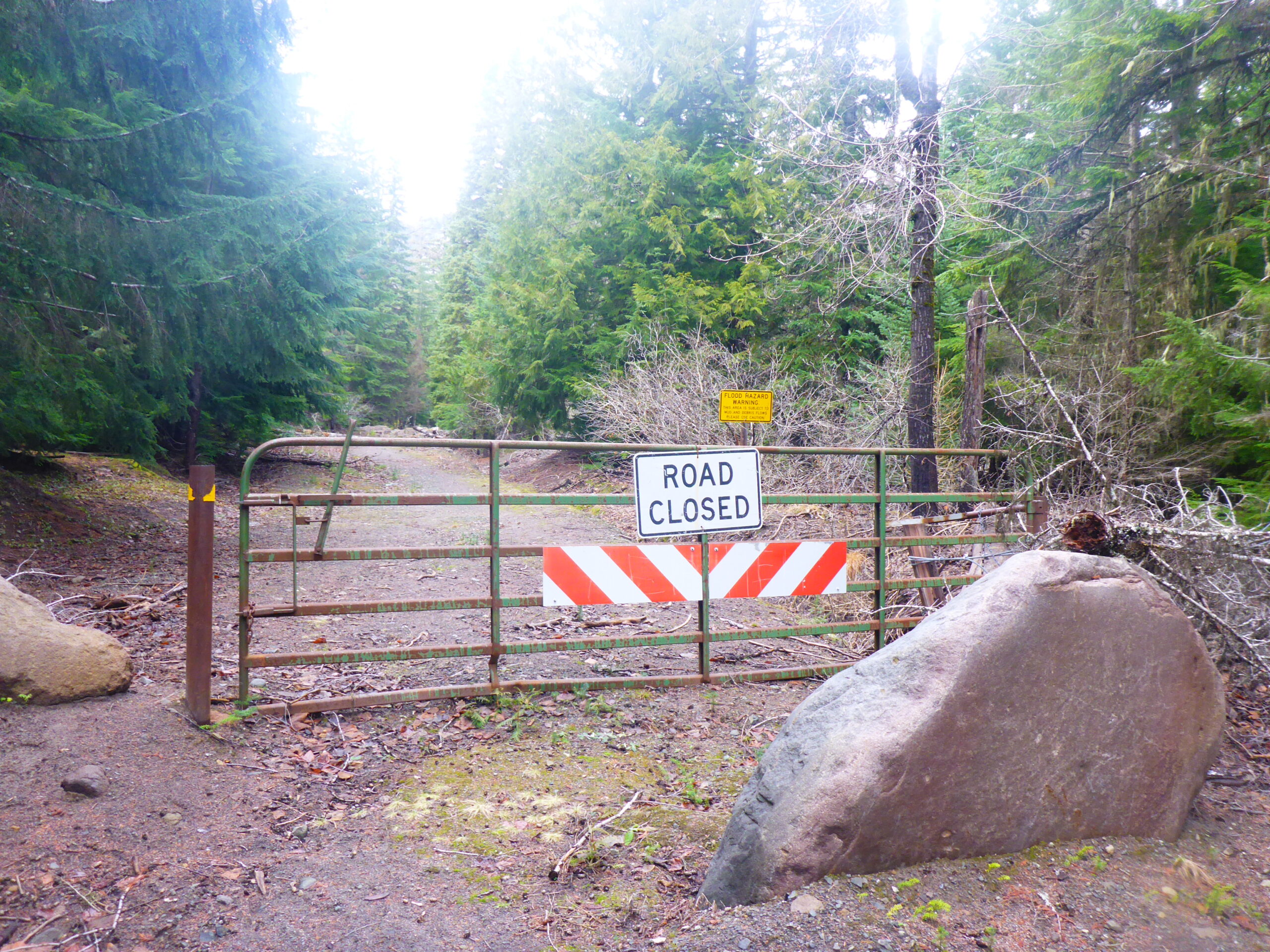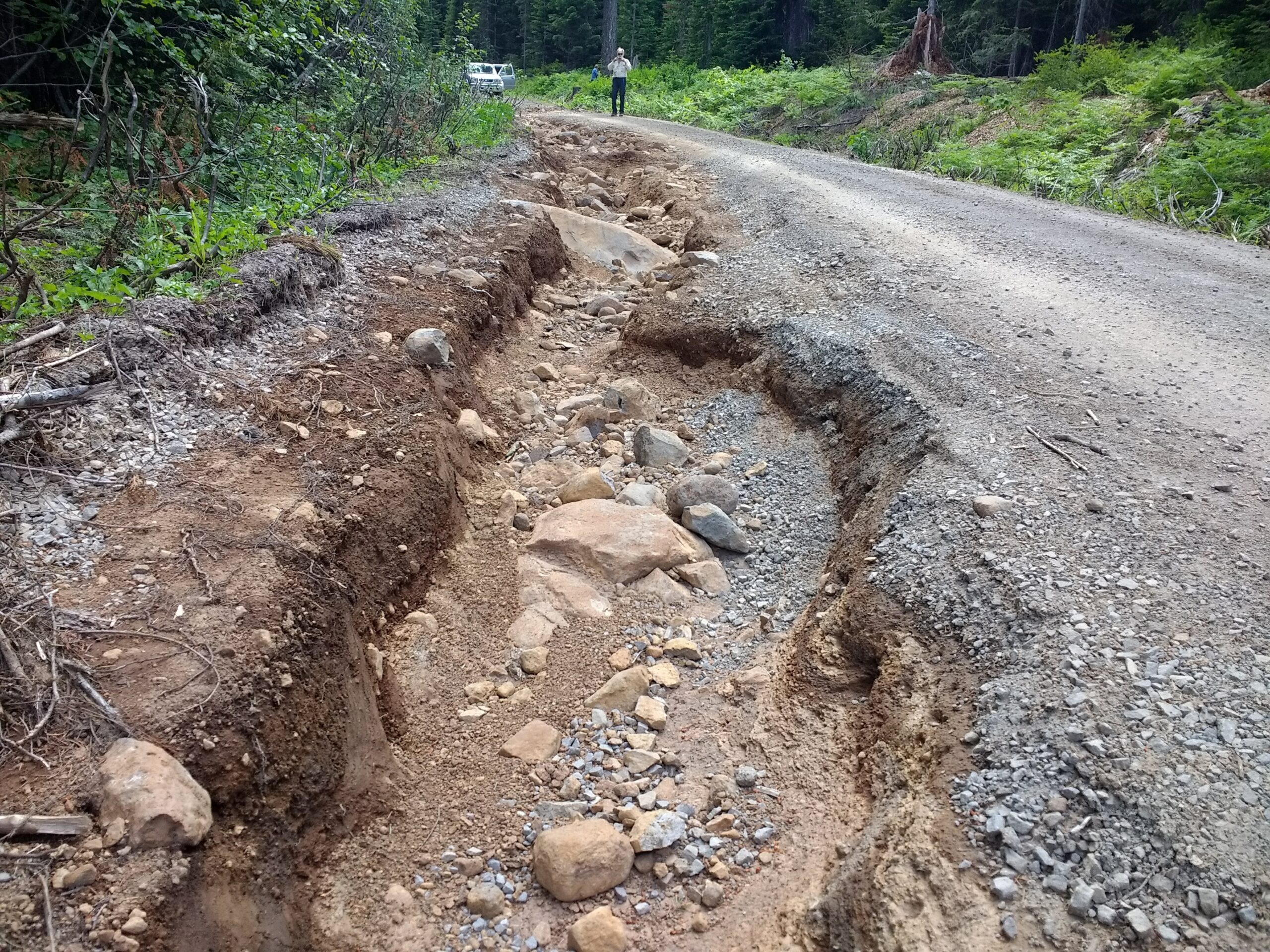Most visitors will not realize that there are thousands of miles of dirt and gravel roads crisscrossing Mt. Hood National Forest. Most of this mileage is not accessible by a typical passenger vehicle because it was designed and built for the transportation of heavy, logging equipment.
Over the past several decades, improvements in environmental regulations have closed many of these logging roads. However, as weather and time deteriorate the existing roads, the surrounding watersheds and ecosystems are also degraded by soil erosion and runoff, illegal trash dumping, and the introduction of non-native species. Bark works to ensure the Forest Service prioritizes decommissioning out-of-use roads. Decommissioning is a restoration project that involves digging up the road surface and de-compacting soils, followed by replanting native species that will thrive in an old road path with an open canopy and finally blocking the road’s old entrance to vehicles with gates or boulders. In some cases, a decommissioned road can become part of a hiking or mountain biking trail. Removing these roads immediately reduces the sedimentation channeled into streams while also discouraging illegal and destructive human activities.
Degraded Water Quality
When water flows down old roads, it gathers sediment along the way which is carried into streams and rivers and quickly makes its way downstream. Mt. Hood’s water-rich landscape provides drinking water to one of every four Oregonians, as well as habitat for five endangered species of salmon. Countless other common species thrive in the temperate rainforest and dry conifer forest habitats that depend on access to clean water. Forest roads can cause up to 130 times the amount of sediment runoff compared to the absorbent nature of the forest floor.
Decreased Habitat
In addition to degrading water quality in aquatic habitat and drinking water sources, roads fragment the habitat of deer, elk, and other wildlife. Additionally, roads increase the frequency of seeds from outside the forest, traveling on tires and on people, to be sown deep in the forest where native species are often stressed or sometimes already overrun by the rapid spread of non-native plants.
Public Safety Concerns
The types of roads that need decommissioning are not suitable for public access. The rough condition of these roads can disable a typical passenger vehicle and often lead to areas of the forest that are less accessible to emergency vehicles. Remote roads are also convenient to those looking for a place to illegally dump trash or stage other dangerous or destructive activities.
Less access?
People may worry that “road closures” will make it hard to get to their favorite spots. However, the Forest Service’s road maintenance budget is not intended to maintain remote and out-of-service roads. The priority for publicly-funded agency maintenance should be focused on keeping the roads which are most used by the public in safe and good condition. By decommissioning unneeded roads, the road maintenance budget can be focused to greater effect upon roads used most by forest visitors. Recreation generates five times as much local revenue as the timber industry.
Bark has worked with the Forest Service for years to help evaluate and eliminate unneeded and harmful roads from Mt. Hood National Forest. In 2007, Bark helped secure congressional funding for the Legacy Roads and Trails program which provided money to initiate decommissioning efforts throughout Mt. Hood. However, there is still much work to be done. In 1999, a Forest Service report concluded that nearly half of the roads in Mt. Hood National Forest are no longer necessary, yet the agency has been slow to decommission these unneeded roads. Bark is committed to seeking outside funding and helping initiate this crucial restoration in the years to come. In 2015, Bark coordinated a PGE grant to restore an old road near Lost Creek.
TAP: Travel Analysis Process
In October 2014, Mt. Hood National Forest officially launched its Travel Analysis Process (TAP), a nationwide project of the U.S. Forest Service to analyze the road networks in each of our public forests. The purpose of TAP is to determine what roads are needed for access in our forests and which roads can be removed.
In December of the following year, the agency released produced the Travel Analysis Report (TAR). This report describes the existing the road system and identifies opportunities to achieve a “more sustainable system of roads,” as defined by the Forest Service. This travel analysis report is part of nationwide requirement involving national forests across the country, but questions remain about how strictly the recommendations in this report will be followed.
The report is not a decision document—instead, it provides a non-binding analysis of where the existing road system is today. The report states:
Currently there are approximately 3,000 miles of roads in the forest. The majority of these road miles (54%) on the forest consist of high clearance roads that have always been “principally intended for managing forest resources and removing timber for lumber.”
The TAR explores two main future scenarios: In the first, the overall road system (open and closed) would be 153 miles smaller than existing. These are the roads that were identified in the Travel Analysis Report as being “not likely needed for future use.” This scenario would result in the maintenance budget being about $400M less annually, falling short of its economic goal. The second alternate scenario would increase the existing number of roads maintained for passenger car use on the forest, but close additional roads not currently suitable for these vehicles, totaling about 200 miles. This second scenario could meet the agency’s economic goal and reduce the annual budget by about $600M at culmination, but according to the Forest Service, would likely “not be in balance with access needs for recreation and the general public, traditional uses, vegetation management, fire suppression, special use permits, cooperators, and special forest products”.
To conclude, the Forest Service claims that “(g)iven the current trend in reduced funding for road maintenance work, and the enormous gap between current funding and need, it does not appear possible to identify a future road system where the entire cost of annual maintenance work necessary to fully maintain the roads to standard would be in balance with available funding.” If this seems stark, one must also consider the fact that the TAR discounts and delays any hard look at the impacts of climate change on the forest along with its current road system. The report reads, “It should be entered into consideration that, while the qualitative nature of this climate change discussion may lack specificity, the utility of this TAP by the end of the next decade will likely have waned, and another analysis of the road system will be mandated to take its place. By then climate shifts may become more certain relative to access needs and risks of roads to natural resources.”
For more information or to ask questions about our work in Road Recovery, contact Jordan, Bark’s Forest Watch Coordinator.


Increment Projects
Associated Files